I wanted to learn how to sail, and was looking for a boat I could easily manage singlehanded and that had enough room for a few friends to join in the fun. I had no previous boatbuilding experience, and while I liked the looks of lapstrake, I thought it might be little overwhelming for a first build.
After many hours of research I settled on the Glen-L 15, a sloop-rigged daysailer. I liked the looks of it, its plywood construction appealed to me, and with a length of 15′1″ and a 6′ beam it was just the right size for me for both building and sailing.
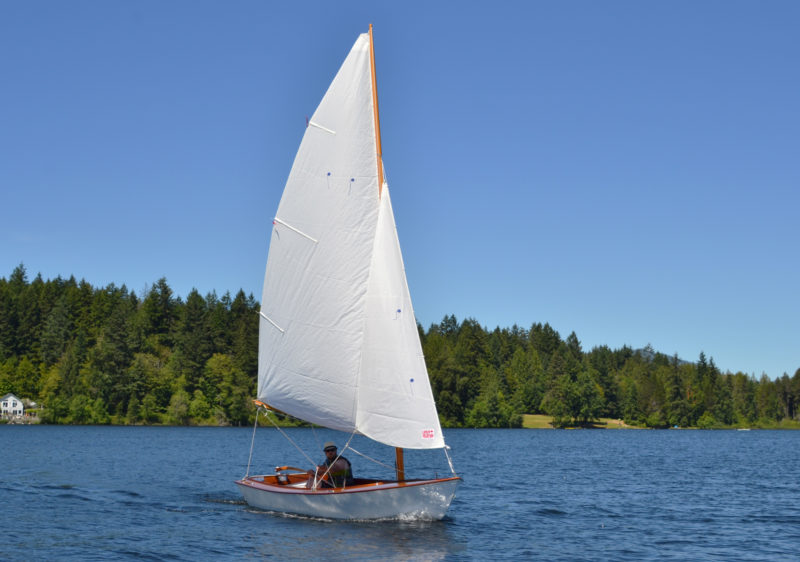 Greg Johnson
Greg JohnsonIn light air, a solo sailor can sit on the side benches, but as the wind approaches 10 knots, it’s time to take a seat on the side deck.
The plans for the Glen-L 15 come with a detailed instruction booklet and full-sized patterns for the frames, transom, stem, and breasthook assembly. There’s no need for lofting; this helps a first-time boatbuilder get started with confidence. I chose vertical-grain white oak for the frames, sheer, and chine logs. Spruce and mahogany are also recommended in the plans. All the wood that I would finish bright was sapele. The hull is constructed of 1/4″ marine-grade mahogany plywood fastened with epoxy and silicon-bronze screws. It goes together quickly, even for a first-time builder, and is easy on the budget.
After fairing and applying fiberglass and three coats of epoxy, the hull was ready for its finish. Paint is the most common finish and recommended in the plans, but I wanted a more durable finish that would require less maintenance. After doing a lot of research, I decided to give gelcoat a try. I ended up with a beautiful finish, and after two years there are no chips, no cracks, and no signs of failing.
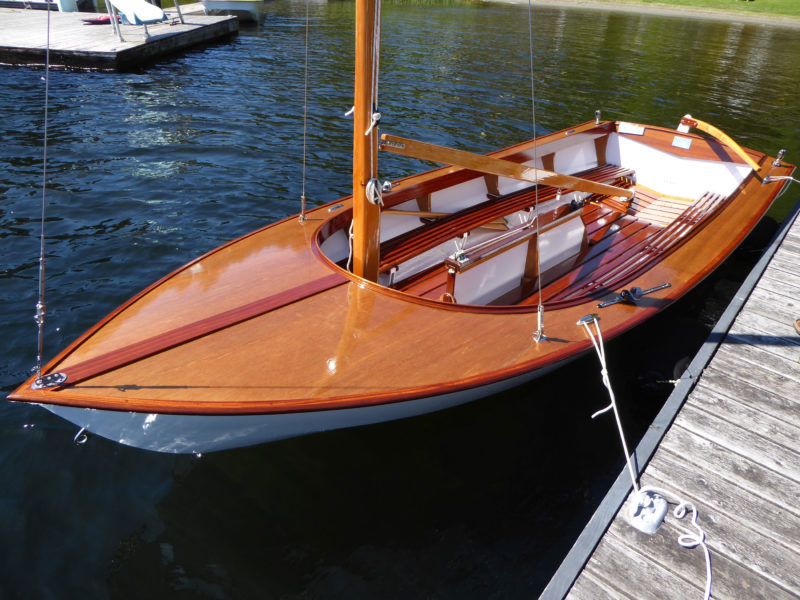 Casey Johnson
Casey JohnsonThe ample seating and uncluttered cockpit of the Glen-L 15 is well suited for introducing family and guests to sailing.
After the hull has been painted, it gets turned right-side up for the remainder of the construction. The two arched beams that support the foredeck need only minimal fairing to prepare them for the marine-grade mahogany plywood decking. The coaming is made of three pieces mahogany milled into 5/16″ x 7″ boards. The finished coaming is about 3-1/4″ high, but you need to start with wide boards to accommodate the crown of the deck. The coaming is steam-bent, then temporarily fastened into place with clamps and screws. After I scribed the designed shape, I removed the pieces, cut them to size, and reinstalled with epoxy and screws for final trimming and sanding.
The seats, floorboards, and rubrails are mostly left up to the builder. I designed the seats and floorboards to be removable to make any future cleaning and refinishing easier. For the seats, the most common method of construction for them that I saw on Glen-L’s forum was to use 1″ x 1″ pieces of hardwood and bend them to follow the curve of the hull’s sides. Instead of screwing the pieces from the top and into the frames, I through-bolted transverse pieces on either side of each frame and epoxied and screwed the 1″ x 1″ slats to them, creating single-piece removable seat. I built the floorboards in a similar fashion to make them in sections easily removed for cleaning and refinishing.
I milled my mahogany trim for the sheer and coaming. There were no instructions on the plans for a rubrail and trim to cover the screws holding the deck at its perimeter, so I made a cap and half-round to cover the sheer. For mounting an outboard motor, I fastened pieces of mahogany to the transom to take the wear and tear of the motor mount. The boat is rated to take an outboard up 7.5 hp.
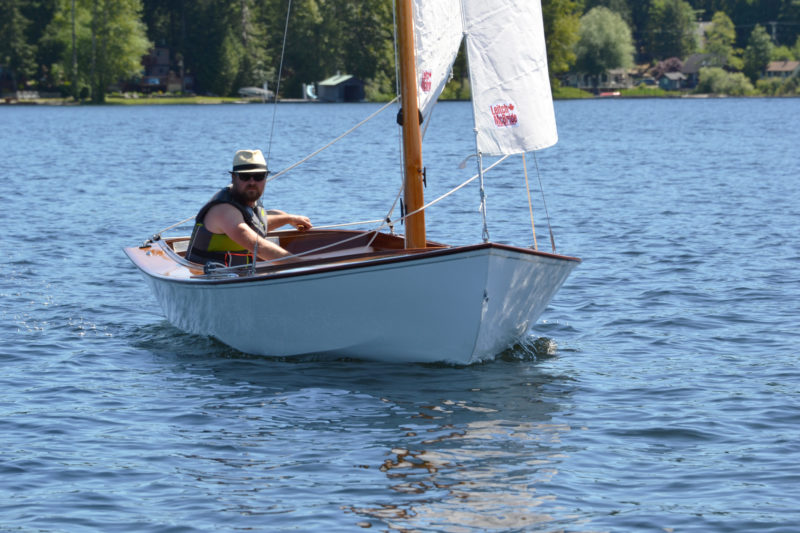 Greg Johnson
Greg JohnsonThe pronounced flare in the forward sections lifts the bow over waves and throws the spray to the sides, keeping it out of the cockpit.
After painting the cockpit and putting nine coats of varnish on all of the brightwork, it was time to think about spars. The plans offered a few options for making the mast. Instead of the hollow plywood mast, I chose to build the solid mast with the sail groove routered into the aft face. I used vertical-grain Douglas-fir 2x4s scarfed and laminated. The mast has the classic teardrop cross-section and is then square below the gooseneck. The boom is rectangular in shape, and there is just one method for building it detailed in the plans. Using the measurements and templates provided, the spar-building wasn’t as difficult as I had expected, and I was very pleased with the results. I ordered the rigging from Glen-L; it was all very high quality and each piece came with diagrams and descriptions to facilitate assembly.
Throughout the build I called Glen-L for guidance, and their staff was patient and knowledgeable and answered any questions I had. The sails were made in British Columbia by Leitch and McBride, sailmakers.
I had spent a year and a half of weekends and some evenings building the boat, and as the time to get ready for launching approached, I had a friend who’s a welder build a trailer using Glen-L’s plans and adding a few custom details. I practiced rigging the boat a few times, and I could get the mast up and the sails ready to raise in about a half hour. The mast is pinned through at the maststep, allowing the mast to pivot up and down. I found it quite manageable to get the mast up solo. The forestay holds it up, and then the two side stays brace it for sailing. A lighter aluminum mast would be easier to handle, but in my opinion the beauty of the wood mast is worth the little extra effort.
At the launch ramp for the first time, the boat slid off the trailer with ease. My father and I used a pair of 4′ paddles to make our way out of the shallows before raising the sails. There wasn’t much wind that morning on Shawnigan Lake, but it didn’t take much to get the boat moving. I was pleased by how effortlessly she glided through the water. Later the wind picked up, and we had a wonderful first sailing experience.
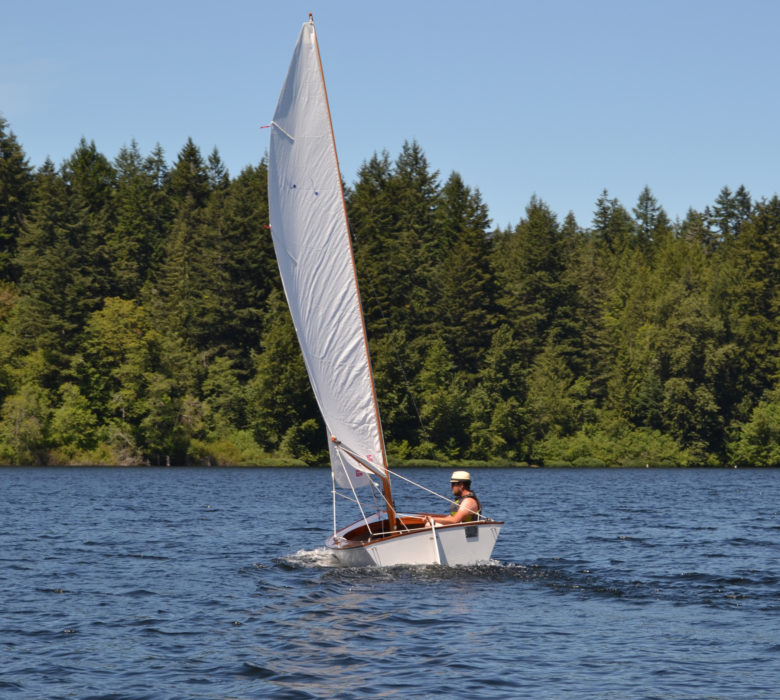 Greg Johnson
Greg JohnsonWhen tacking, the bow swings smartly through the eye of the wind and is unlikely to get caught in irons.
I learned a lot that first summer, sailing every chance I got. The Glen-L 15’s 114 sq ft of sail area provides spirited sailing. The centerboard is weighted and raised and lowered with a pulley system. When running downwind I found with pulling the centerboard up I could get more speed and still feel stable and in control. When turning from running downwind into a beam reach, I just need to remember to lower the centerboard well before I turn or the lateral pressure will not allow the board drop freely, especially in strong wind. On a broad reach I’ll usually pull the centerboard up about halfway.
I can control the jibsheet, mainsheet, centerboard, and tiller all from a seating position at the stern, so I haven’t found the need for a tiller extension. The arrangement is great for solo sailing and when taking guests out who just want to enjoy the ride rather than tend sheets. The boom sits high, so there’s good visibility forward and no need to duck when coming about. This makes navigating and taking care of passengers easy. I’ve sailed with four adults in light to moderate winds, and the boat performs well. The boat points high when working to windward. There’s plenty of room for three on one side bench when I need to counter heeling in strong winds. If I trim the sails properly, the Glen L-15 holds a course very well on all points of sail and has a near neutral helm—I never have to fight the tiller. When setting the mast rake I was careful to stick to the plans and get it right. I believe this was an important factor to creating a balanced helm.
The winds on my home waters—Shawnigan Lake—can change direction quickly, and large wakeboard-boat wakes makes for a challenging yet fun experience. The boat maneuvers extremely well; it’s very stable without compromising handling or speed. There’s plenty of room for four adults while sailing with ample storage under the foredeck for life jackets, picnic supplies, an anchor or whatever you might need for a daysailing adventure. I bought an electric trolling outboard for those lazy summer evenings on the lake; all the kids take turns playing captain. When the winds are down, the Glen-L 15 can easily be used as a runabout or for fishing
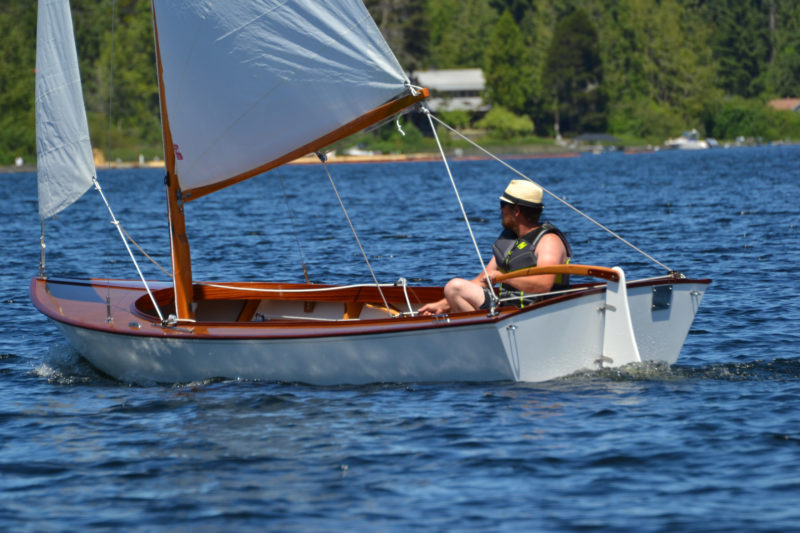 Greg Johnson
Greg JohnsonThe boom and the foot of the jib are both set high, providing a clear view forward and eliminating the need to tell passengers to duck when coming about.
The Glen-L 15 has lived up to my expectations and has been a great boat for learning to sail in a variety of conditions. It usually draws a crowd and a lot of compliments and questions wherever I go. The experienced sailors who have seen the boat say I’d have no problem exploring the protected coastal waters of the British Columbia coast. My next project is to design sleeping arrangements for two on either side of the centerboard trunk for camp cruising. The Glen-L 15’s versatility would make it a boat almost everyone can enjoy.![]()
Kelsey Johnson was born and raised in Victoria, British Columbia, and grew up waterskiing, surfing, and snow skiing on Vancouver island. A journeyman carpenter by trade, he and his brother own a construction company and build custom homes in Victoria and surrounding areas.
Glen-L 15 Particulars
[table]
Length/15′ 1″
Beam/6′
Depth amidships/24″
Draft, board up/7″
Draft, board down/3′ 4″
Weight/370 lbs
Sail area, main/90 sq ft
Sail area, jib/24 sq ft
[/table]

Plans and patterns and parts kits for the Glen-L 15 are available from Glen-L’s online store.
Is there a boat you’d like to know more about? Have you built one that you think other Small Boats Monthly readers would enjoy? Please email us!

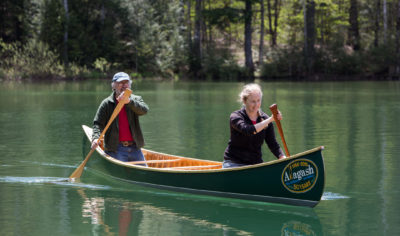
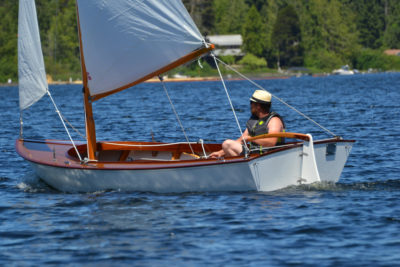
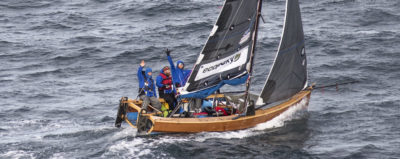
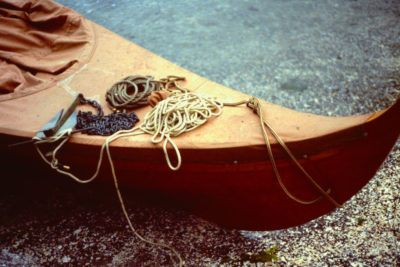
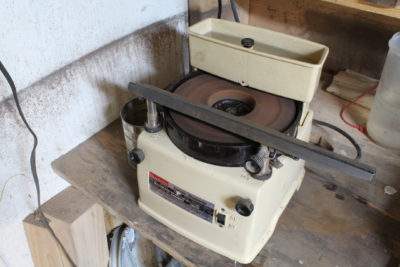
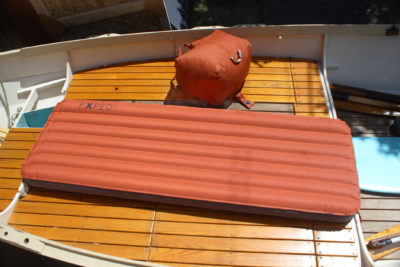
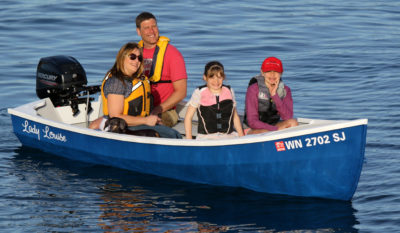
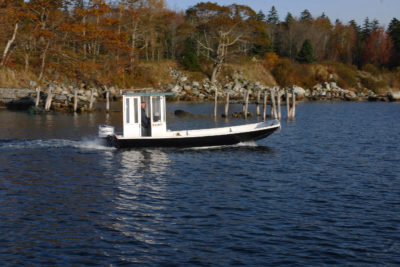

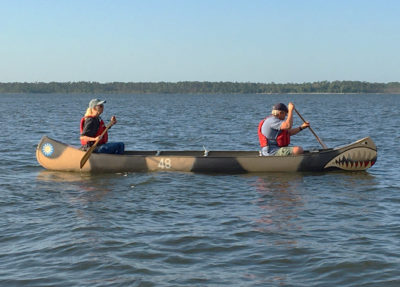
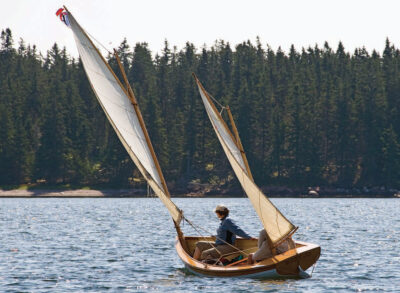
Nice job. The world is a more beautiful place thanks to your efforts.
Congratulations, she looks great! One point: Have you thought of fitting a kicking strap or have you found that unnecessary for most uses? I am now thinking of building one myself over here in England however I am wondering whether to gaff-rig a Glen-L 15, even with a small bowsprit—a sail plan I am particularly fond of as the spars are shorter and I think it would look very good. Happy sailing!
I built a GlenL 15 with plans purchased in about 2007. My boom is mounted much lower on the mast than yours and I believe mine was built to plan. Did you modify the boom placement from your plan or perhaps the plan changed since I built mine? Any idea?
I like your boat as it gives much more room in the cockpit with the boom higher.
Thanks,
Scott
Loved the article and you did a fantastic job on the build. I am in the process of building a Glen-L 14 and will incorporate many of your ideas.